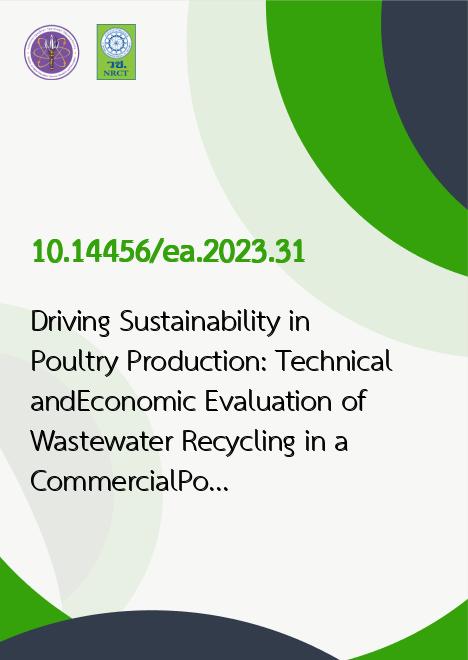
|
Driving Sustainability in Poultry Production: Technical andEconomic Evaluation of Wastewater Recycling in a CommercialPoultry Hatchery |
|---|---|
| รหัสดีโอไอ | |
| Creator | 1. Fachmi Azhar Aji 2. Dwi Nowo Martono 3. Kosuke Mizuno |
| Title | Driving Sustainability in Poultry Production: Technical andEconomic Evaluation of Wastewater Recycling in a CommercialPoultry Hatchery |
| Publisher | Thai Society of Higher Education Institutes on Environment |
| Publication Year | 2566 |
| Journal Title | EnvironmentAsia |
| Journal Vol. | 16 |
| Journal No. | 3 |
| Page no. | 1-14 |
| Keyword | Commercial Poultry Hatchery, Wastewater recycling, Cost Benefi t Analysis, Groundwater Intensity Ratio, Pollutant Removal |
| URL Website | http://www.tshe.org/ea/index.html |
| Website title | EnvironmentAsia |
| ISSN | 1906-1714 |
| Abstract | Substantial growth of poultry industry had raised concerns about its environmentalimpact, particularly in relation to groundwater depletion and pollution. One potentialsolution to mitigate these issues is the implementation of a wastewater recycling system(WRS) which is not widely adopted in poultry industry due to a limited informationon its technical and economic feasibility. Therefore, this study aimed to investigate theapplication of WRS in a commercial poultry hatchery in Indonesia and how it can beadopted widely to drive sustainability in poultry production. The technical aspect of theWRS was examined by evaluating its performance in removing pollutants and capabilityof reducing groundwater intensity ratio (GIR). Furthermore, the economic feasibility wasexplored through a cost benefit analysis (CBA), using net present value (NPV) as soleindicator expressed in United States dollar (USD). The results showed that multistagewastewater treatment applied in WRS consist of physical, biological & chemical process,and the removal percentage of biological oxygen demant (BOD), chemical oxygen demand(COD), total suspended solids (TSS), fat oil and grease (FOG) pollutants ranged from47.5 - 95.1%, 48.4 - 91.3%, 24.9 - 95.3% and 68.0 - 89.3%, respectively. Furthermore,all the recycled water managed meet Indonesia quality standards. The application ofWRS reduce groundwater withdrawal through the reduction of GIR by 30.18%. Thisdecreased the reliance on groundwater sources without affecting productivity. The costbenefit analysis conducted on the WRS has uncovered numerous economic benefitssuch as cost saving in water bills and avoidance of pollution-related expenses withestimated positive NPV at USD 30,742.54 which exhibits economic feasibility. Thestudy concluded that WRS remains a viable option for widespread implementation inthe poultry industry, addressing water crisis and promoting sustainable production. |